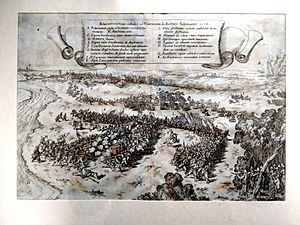Battle of Rijmenam (1578) facts for kids
Quick facts for kids Battle of Rijmenam |
|||||||
|---|---|---|---|---|---|---|---|
| Part of the Eighty Years' War | |||||||
 Spanish attack on the States army, by Frans Hogenberg. |
|||||||
|
|||||||
| Belligerents | |||||||
| Commanders and leaders | |||||||
| Strength | |||||||
| 18,000 infantry 2,000 cavalry |
12,000 infantry 5,000 cavalry |
||||||
| Casualties and losses | |||||||
| 400+ dead or wounded | Between 400 and 1,000 dead or wounded | ||||||
The Battle of Rijmenam was an important fight during the early part of the Eighty Years' War. This war was when the Netherlands fought for its freedom from Spain. The battle happened on July 31, 1578, near a place called Rijmenam in what is now Belgium. In this battle, the forces of the Dutch States-General and their allies defeated the Spanish army.
Contents
Why the Battle Happened
After a peace agreement called the Pacification of Ghent, all the Dutch lands under Spanish rule had risen up against King Philip II of Spain. A new Spanish leader, Don Juan de Austria, arrived in 1576. At first, he pretended to want peace. But soon, the fighting started again.
Spanish Strength Grows
By early 1578, Don Juan received many more soldiers from Spain. This made his army strong enough to attack. He won a big victory at the Battle of Gembloux. This made other countries worried.
Help for the Dutch
To help the Dutch, Queen Elizabeth I of England sent money and soldiers. The Duke of Anjou from France also sent troops. These new soldiers formed the main part of the Dutch army. They set up a strong camp at Rijmenam in July 1578.
The Armies Gather
The Dutch army was led by the Count of Boussu. It included many English soldiers, led by Sir John Norris and Sir Richard Bingham. There were also Scottish soldiers under Robert Stuart and French Huguenots (French Protestants) led by François de la Noue. Before the battle, this army had about 18,000 foot soldiers and 2,000 horse soldiers. They were waiting for more help from the Count Palatine.
Don Juan's Spanish army was smaller. He had about 12,000 foot soldiers and 5,000 horse soldiers. He wanted to attack before the Dutch army could get more troops. Even though some of his top commanders, like the Duke of Parma, thought it was too risky, Don Juan decided to attack.
The Battle of Rijmenam
Don Juan's army attacked early in the morning of July 31, 1578. The Dutch army was set up in front of the village of Rijmenam. Their sides were protected by forests. They had also dug trenches in front of their position.
The Spanish Attack
Don Juan hoped the Dutch would come out of their trenches and fight in the open. But the Count of Boussu, the Dutch commander, did not move. After waiting for three hours, Don Juan tried a trick. He sent some musketeers and cavalry to pretend to attack the back of the village.
The Count of Boussu fell for the trick. He ordered Sir John Norris to stop them. A small fight started, but it didn't go anywhere at first.
The Trap is Set
However, a few English soldiers got lost between the armies. This brought in more soldiers from both sides. Scottish soldiers and Spanish infantry came forward. At the same time, the entire Spanish foot army began to move towards the trenches. The Duke of Parma bravely led them on foot.
Meanwhile, the Spanish pushed Norris's soldiers back into the village. Norris then fought back, setting fire to some houses. The Spanish leaders thought this meant the Dutch were burning their supplies and running away. So, they pushed their attack even harder, even though Don Juan and Parma tried to stop them.
When the Spanish soldiers reached the middle of the village, they realized they had been tricked. The Dutch army had only seemed to be in front of the village. Their main, strong camp was actually behind the village. Their cannons were set up in front of their real battle line.
The Dutch Counterattack
About 500 Spanish musketeers and 600 cavalry found themselves in a very dangerous spot. The Scottish soldiers, singing psalms, attacked the surprised Spanish. At the same time, the Dutch cannons opened fire. The Spanish troops were in danger of being completely wiped out.
However, the Duke of Parma personally led them out of the village using a hidden path. He also performed one of his famous cavalry moves to protect them. This ended the battle, as the Dutch did not chase them.
Reports about how many soldiers died are different. Dutch historians say about 1,000 Spanish soldiers were killed. Spanish historians say only about 400 died, and the same number on the Dutch side. However, Spanish reports admit more of their soldiers were wounded or captured.
What Happened Next
After the battle, Don Juan first went to Tienen. But soon, he had to retreat further to Namur. This meant he lost most of the land he had gained after his victory at Gembloux. Don Juan died suddenly from an illness, probably typhus, on October 1, 1578, while camped near Namur.
See also
 In Spanish: Batalla de Rijmenam (1578) para niños
In Spanish: Batalla de Rijmenam (1578) para niños


